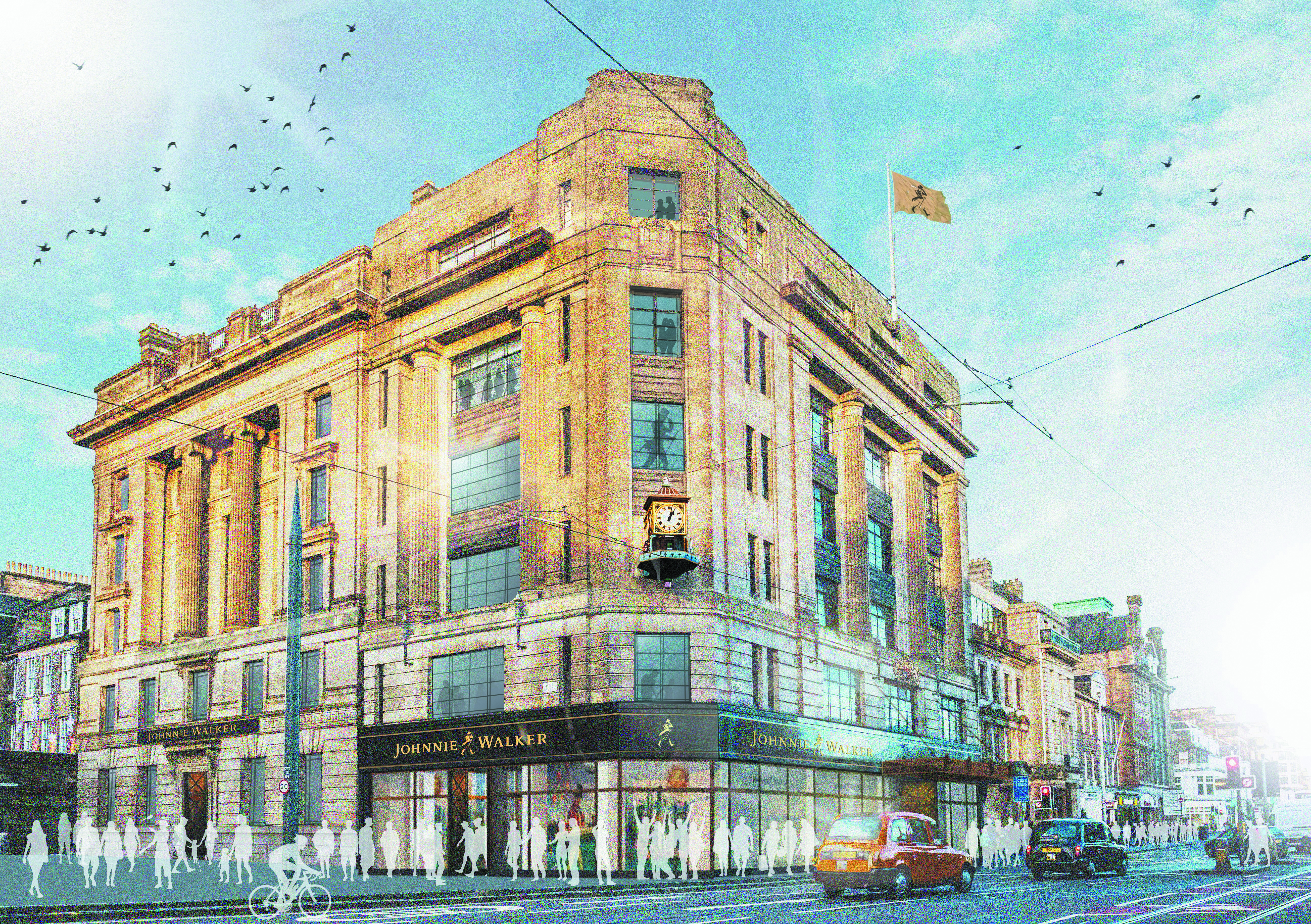Diageo has unveiled its grand master plan for scotch whisky tourism. David Cutter is the man to make it happen. Eamonn Duff reports

Chairman, Scotland
Diageo
It’s been a standout few months for Diageo’s David Cutter. When the world’s largest spirits producer reaffirmed its environmental commitment with some managerial fine-tuning late last year, he emerged as the company’s first Chief Sustainability Officer (CSO). In addition to the new position, Cutter will continue in his role as President of Global Supply and Procurement and continue to sit on the company’s executive committee. As Chairman of Diageo in Scotland, he has also just signed off on the company’s striking £185 million investment plan for Scotch whisky tourism. In the coming months, work will begin on transforming Diageo’s 12 existing distillery attractions across Scotland. However, the focal point of the spend is a stunning, seven-floor flagship Johnnie Walker visitor attraction in one of Edinburgh’s most prestigious, heritage buildings. The development plans were formally submitted to City of Edinburgh Council several weeks ago and involves a “meticulous restoration” of the historic Princes Street property. Diageo’s mission is to create a ‘must visit’ Johnnie Walker equivalent of its own supremely successful Guinness Storehouse tourist attraction in Dublin. More than 1.7 million visitors passed through its doors in 2017 and Cutter cannot wait to get started. “We are incredibly excited to be able to submit our plans for the Johnnie Walker visitor experience,” he said.

“The location is one of Edinburgh’s most exceptional landmark buildings and we plan to restore it to its former glory as a cornerstone of the city and a thriving part of its cultural and social life.” Diageo’s investment represents the biggest single investment in Scotch whisky tourism and includes a £35 million undertaking to revive two iconic lost distilleries which have laid dormant for more than three decades. Port Ellen Distillery on the famous whisky island of Islay, and Brora on the remote eastern coast of Sutherland, will both be reinstated to distil in carefully controlled quantities. In the 34 years since the sites have been shut, the whiskies they produced have become some of the most highly prized on the market. “This is no ordinary Scotch whisky investment. This is a once in a lifetime opportunity to bring these iconic distilleries back to life,” said Cutter who is leading the capital investment programme across both locations. “We will take great care to be true to the spirit of the original distilleries in everything we do and operate them with all the knowledge, skill, craft and love of Scotch that our people and our company has gathered through centuries of whisky-making.” Scottish whisky tourism has recorded unprecedented growth in recent years. There are 122 operating malt distilleries across the country, more than half of which are open to the public. According to Scotch Whisky Association (SWA) figures, there were almost 1.9 million visits to Scotch whisky visitor centres in 2017, up 11 percent on the previous year and a rise of 45 percent since 2010. On average, each tourist spent £32 during each trip to a visitor centre – a year-on-year increase of almost 4 percent.
We have the most passionate and skilled whisky-makers in the world here in Scotland and we want to celebrate their craft
Last summer, Macallan unveiled its new £140 million distillery and visitor experience, a space-age structure located on the brand’s Easter Elchies estate. Around the same time, independent Scotch malt whisky bottlers Hunter Laing opened its new beautifully-designed, £8 million Ardnahoe distillery boasting sweeping views of the Sound of Islay.
As state-of-the-art expansions continue across the country and new whisky trails emerge, Scotland is being propelled to the forefront of the global boom in experiential travel. “We have the most passionate and skilled whisky-makers in the world here,” declared Cutter, adding: “We want to celebrate their craft and everything that’s great about Scotland and whisky.” Prior to joining Diageo 15 years ago, Cutter found his feet in manufacturing, supply and product management, holding leadership roles at FMCG companies including Frito-Lay and SC Johnson. After initially heading Diageo’s Asia Pacific Supply business in Singapore, he became President of Supply across the Americas in 2009, overseeing the company’s end-to-end supply operations in North America, Latin America and the Caribbean. During this time, he also delivered a new 20 million proof gallon rum distillery in the US Virgin Islands. In July, 2014, he moved to Europe after being appointed President of Global Supply and Procurement. Based out of Diageo’s headquarters in Edinburgh, he’s currently responsible for a global supply chain that delivers brands to 180 markets around the world, from 100 plus production facilities, located in more than 30 countries. On his LinkedIn profile, he describes it as a “great privilege” to lead the business area in Diageo that’s responsible for the creation and making of some of the world’s most admired brands including Smirnoff, Baileys, Tanqueray, Guinness – and of course Scotland’s own Johnnie Walker. He adds: “They are brands built by entrepreneurs with rich heritage and are made with care, craft and tradition.” None of those celebrated brands have greater pull than Johnnie Walker which holds the distinction of being the world’s most popular Scotch whisky – and according to Impact Databank, is the most valuable premium spirit brand on the planet. From its humble origins in a Kilmarnock grocery shop that was opened by John Walker in 1820, the brand has occupied Scotch Whisky global top spot since the sixties and has retained that position thanks, in part, to its instantly recognisable bottle, slanting label and striding man logo, first sketched by cartoonist Tom Browne in 1908.
The brand became part of the Diageo stable in 1997 when the company was born… it’s been a match made in heaven ever since.
The brand became part of the Diageo stable in 1997 when the company was born from a merger between Guinness and Grand Metropolitan. It’s been a match made in heaven ever since. In 2014, Richard Paterson, renowned master blender at Whyte & Mackay, remarked that the brand’s success was largely down to the affection that had been lavished upon it by Diageo. “It is the life blood of Diageo,” he observed. “If Johnnie Walker was to stumble badly, the whole company would start to crack.” If recent investment and innovation is any indicator, Diageo is never going to let that happen. As reported by FMCG CEO last month, a masterstroke ‘White Walker’ collaboration between the drinks giant and the US blockbuster HBO series Game of Thrones last October (below) triggered 5.8 percent net sales growth in the first half to December 31 – and a 9 percent rise in global Johnnie Walker sales. Closer to home, it’s estimated that when the new Johnnie Walker headquarters opens, it will generate between 160-180 full-time equivalent jobs and approximately £135 million in annual tourism spend.

While whisky from all of Diageo’s Scottish distilleries contributes to Johnnie Walker, four distilleries – Glenkinchie, Cardhu, Caol Ila and Clynelish – will be linked directly to the new tourism venue in Edinburgh, representing the ‘four corners of Scotland’ and the regional flavour variations crucial to the art of whisky blending. Together these sites will create a unique Johnnie Walker tour of Scotland, encouraging visitors to the capital city but to also travel to – and support – the country’s outstanding rural communities. As the company’s inaugural CSO, Cutter will be on hand to ensure the project showcases long-term sustainability. “Across our diverse supply chain, I see first-hand the positive impact our operations can have on the communities around them,” he said. “Whether it is ensuring our sites have leading energy efficient technology, reducing fuel and water consumption or supporting our vast global family of farmers providing grains to our breweries and distilleries, this is a huge and significant role. I fervently believe in the significant contribution we can make and our commitment to do so.”



